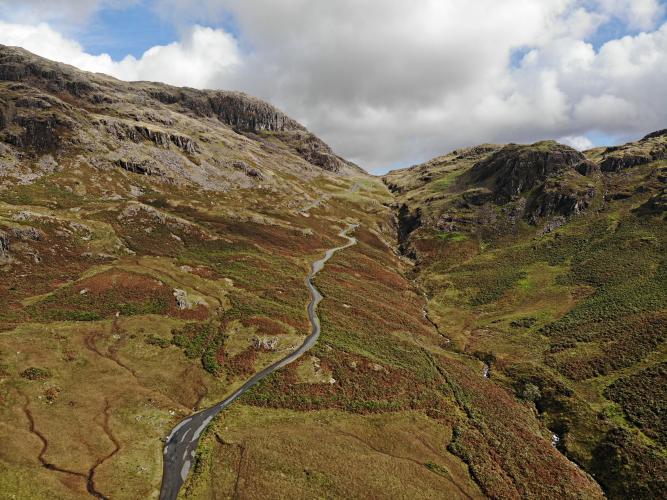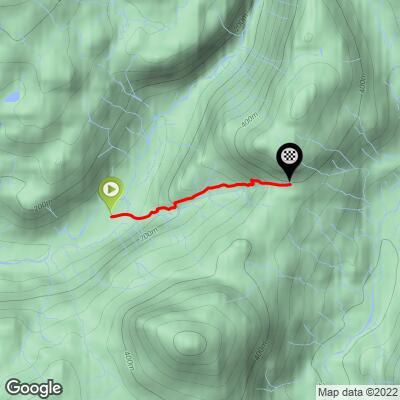![Cycling Hardknott Pass West panoramic photo shows bike parked on rocks next to roadside, rocky hillside]()
Cycling Hardknott Pass West
Ride 1.4 miles gaining 1,003’ meters at 13.5% average grade.
This is a magnificent bucket list climb for all cyclists interested in an epic bike climb. This is our favorite of Simon Warren’s 100 Greatest Cycling Climbs. Hardknott Pass is a 10/10 in Simon Warren’s book, and while that means its difficulty is 10 on a scale of 10, it could be a 10 for it’s stunning surroundings and scenery. This ride is simply an amazing experience.
Be sure to also visit our 100 Greatest Cycling Climbs, Great Britain, Top Climbs of the UK, and Most Epic Bike Climbs of the UK for more Great Britain cycling climbs.
![Cycling Hardknott Pass West photo collage shows road sign for 30% grade, road spray painted "well done"]()
Simon Warren (Britain’s top cycling climbing books) provided us his lists of the Top 10 Hardest and the Top 10 Most Epic bike climbs of England, Wales, Scotland, and Britain before our second (2022) very extended trip to document the greatest bike climbs of the United Kingdom. Simon has a clear fondness for Hardknott Pass and rightly so, in our opinion. We’ve ridden both sides twice and would come back a third, fourth, and fifth time if the opportunity presents itself. Simon ranks Hardknott Pass #2 England, #5 Hardest, and England #3, UK #6 Most Epic.
![Cycling Hardknott Pass West PJAMM's Profile Tool for Hardknott's Pass]()
Soooooo Steep: One quarter-mile is at 20.4% average grade.
Image is from PJAMM Cycling’s Profile Tool for Hardknott pass.
“The king of climbs and arguably the hardest road in the land, the legendary Hardknott Pass is an amazing sliver of tarmac. First built in 2AD by the Romans, the pass is unbelievably tough from both directions,” Simon Warren (100 Greatest Cycling Climbs: A Road Cyclist’s Guide to Britain’s Hills, p. 143).
![Cycling Hardknott Pass West photo collage shows bike parked next to stone fence, old red telephone booth]()
PJAMM’s Brad Butterfield writes of Hardknott Pass West:
The Western side of Hardknott Pass is truly the creme de la creme of English cycling climb. Directly in the heart of the Lake District National Forest, Hardknott’s Pass is made for magazine covers. The serpentine road follows the path of a deep canyon up to the summit point and is on display from the very start of the climb. The sharp curves are not only a struggle to pedal up, but challenge any car that dares to drive the route - and they do. This road is a very popular tourist destination and you’ll undoubtedly be in the company of many cars while on the climb. The summit is unmarked and very on-brand for the climb. One of the aspects of the ride that makes it special is its remote and untouched feel. The road is rough, treacherous, and bloody amazing. Certainly one of my top climbs in all of the UK.
![Hardknott Pass #84 Simon Warren 100 Greatest Cycling Climbs Bicycle climb Hardknott Pass #84 Simon Warren 100 Greatest Cycling Climbs - bike, pjamm jackete at top on pile of rocks]()
This climb is in the Lake District and included annually in the Fred Whitton Saddle Back Challenge, one of the most popular sportives in the UK. See the PJAMM Fred Whitton Challenge Climb Page for more information.
![Cycling Hardknott Pass West aerial drone views show roadway cutting through lush green hillside]()
A nice Cycling Uphill article by Tejvan of April 24, 2014 notes:
“Haven’t ridden all the climbs in the UK, but it will be hard to beat Hardnott Pass for difficulty, drama and the beauty of the surroundings. I always think of Hardknott and Wrynose pass as the King and Queen hill climbs of England. In terms of overall length and height gain, it is not particularly spectacular. But, the great attraction (or should I say feature) of Hardknott is its unrelenting steepness. Sometimes 1/3 signs overrate the gradient of the actual climb. But, with Hardknott pass, the 1/3 is really merited. No matter which line you take, you can’t avoid considerable sections of 30%. This is really steep; it’s so steep you can have a strange feeling that you might fall over backwards when climbing. No matter how fit or not you are, getting up Hardknott pass gives a sense of achievement, which is hard to replicate on longer, but shallower climbs” (Read more).
![Cycling Hardknott Pass West photo collage shows views of green heather surrounding roadside]()
The heather is green at the beginning of the summer and purple during the fall.
![Cycling Hardknott Pass West photo collage; PJAMM Cycling bike parked against roadside, lush green landscape]()
![Cycling Hardknott Pass West photo collage shows sharp hairpin turns in roadway; road spray painted to read "A good effort," and You've done it! Yay!"]()
One of the most popular climbs in the UK (27,829 Strava attempts as of 10-6-18 and 50,331 8-30-22).
Wikipedia provides some history on the pass:
“A road over the pass was built by the Romans around AD 110 to link the coastal fort and baths at Ravenglass with their garrisons at Ambleside and Kendal. The Romans called this road the Tenth Highway. The road fell into disrepair after the Romans left Britain in the early 5th century, although it remained as an unpaved packhorse route thereafter. The road was originally used entirely for military traffic, but following the Romans' retreat from Britain was used to transport lead and agricultural goods. By the early Middle Ages, the road was known as the Waingate ("cart road") or Wainscarth ("cart pass"): there is an 1138 record of a party of monks traversing it in an oxcart. Hardknott pass and its surrounding area fell within the domain of the Lords of Millom, being situated between the headwaters of the Esk and Duddon. Grazing and hunting rights were given to the monks of Furness Abbey by the Lords of Millom in the 13th Century, which they held until the dissolution of the monasteries (1536-41)” (Hardknott Pass).
![Cycling Hardknott Pass West informational sign for Hardknott Roman Fort]()
Roman fort plaque at 6/10ths of a mile.
![Cycling Hardknott Pass West photo collage shows PJAMM cyclist riding down roadway surrounded by green heathered hillsides]()
Views looking west from near the finish.
These climbs are within Lake District National Park, 236,200 hectare (583,663 acres) established in 1951:
“The Lake District, also known as the Lakes or Lakeland, is a mountainous region in North West England. A popular holiday destination, it is famous for its lakes, forests and mountains (or fells) and its associations with the early 19th century writings of William Wordsworth and the other Lake Poets, Beatrix Potter, and John Ruskin. A National Park was established in 1951 and, following a minor extension in 2016, now covers an area of approximately 2,362 square kilometers. It was designated as a UNESCO World Heritage Site in 2017.” (Lake District National Park).
![Cycling Hardknott Pass West PJAMM cyclists at climb's finish in 2018 and 2022]()
Finish - photos top left and bottom - 2022; top right 2018.
![]()
That’s a wrap!

 We've partnered with Sherpa-Map.com to bring you the best route planning tool. With a PRO Membership you can use this climb as a reference when creating your route.
We've partnered with Sherpa-Map.com to bring you the best route planning tool. With a PRO Membership you can use this climb as a reference when creating your route. 

